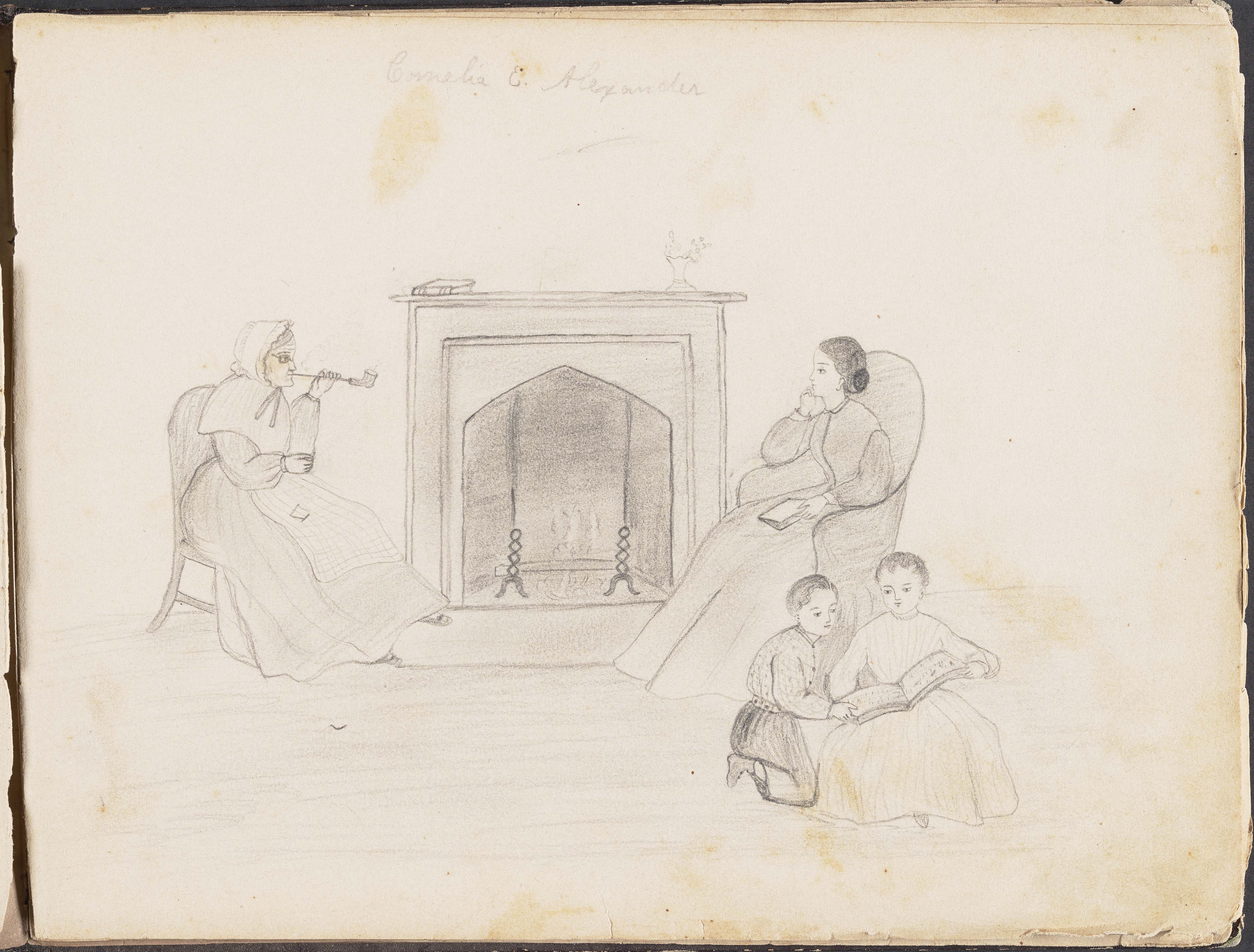Cornelia’s World: A Perspective on Life in 19th Century Mecklenburg County is a solo exhibit on display through May 1 on the 10th floor. The exhibit features a previously-overlooked book of drawings from Cornelia Elizabeth Alexander (1844-1877), a young woman from the Huntersville area who studied at Concord Female College (now Mitchell Community College) in Statesville, N.C.
The sketchbook, part of the Davidson Family Papers in Special Collections & University Archives, is a remarkable combination of history and art. Cornelia Alexander’s drawings, which include portraits (both human and animal), landscapes, architecture, and still lifes, offer unique insight into life in the old south. Through them we can see the world from a young woman’s perspective.
In his curator's statement, Chad Allen discusses the historical research behind the exhibit:
The greatest challenge of building an exhibit around this sketchbook was also the reason why I wanted to do it. It was the fact that we knew so little about it or its creator. None of the book’s 39 drawings are dated, nor is there any information about the people and places depicted. The only substantial hint the book offers (besides what is in the drawings themselves) was that its author was “Cornelia E. Alexander. Concord Female College. N.C.”
By knowing her name, I could consult genealogies of the Alexander family and fairly quickly discover when she was born and who her family was. However, these types of sources also fairly quickly demonstrated their limitations. I learned from these sources that Cornelia and her sister Violet (who is the likely subject of several of the portraits) both died relatively young and were never married. Therefore genealogists, mostly men writing in the early 20th century, wrote nothing else about them besides “died young; never married.” Additionally, none of Cornelia’s letters appear to have survived. Fortunately, census records were helpful in shedding light on what Cornelia’s life was like. The 1860 census reveals that the Alexanders were wealthy cotton planters who enslaved 28 people, which was more than the average enslaver in the county.
The Davidson Family papers also include contemporary photographs of Cornelia and her family, which are featured in the exhibit alongside the drawings. The exhibit also explores Cornelia’s connection to Concord Female College. Records from Mitchell Community College reveal that Cornelia’s sister Violet also attended the school. The Alexander sisters received a rigorous secular and religious education. In addition to art and music, Concord students also studied science, mathematics and philosophy.
The fact that Cornelia presumably made these drawings around the time she was a college student adds another element to consider. Cornelia was born in December 1844, meaning she would have attended college in the middle of the Civil War. Cornelia’s idyllic portrayal of North Carolina plantation life stands in sharp contrast to the upheaval we commonly associate with the Civil War. The best explanation for this apparent discrepancy is that Mecklenburg County was relatively far from the front lines.
Charlotteans often think of their city as a very modern place, whose history began only recently. We also tend to imagine the 19th Century through the lens of the black and white photography of the era. People in 19th Century photographs often look unnaturally stern or rigid, but that was simply because they had to sit still for several minutes while their photographs were being taken. This exhibit offers visitors both a window into Charlotte’s early history and a different perspective on life in the 19th Century.
The curator would like to give his special thanks to John Blythe, Lynn Bancroft, and the Huskins Library staff at Mitchell Community College for their kindness and invaluable help in researching this exhibit.
--Chad Allen
Chad Allen is a graduate assistant with Special Collections & University Archives and an M.A. student in UNC Charlotte’s public history program. His area of research is the American South and the War of 1812.
Primary Sources:
Davidson Family Papers, MS0188, Special Collections & University Archives, UNC Charlotte.
Mecklenburg County, North Carolina population schedule. 1860 U.S. census. National Archives microfilm publication M653. Washington, D.C.: National Archives and Records Administration.
Mecklenburg County, North Carolina slave schedule. 1860 U.S. census. National Archives microfilm publication M432. Washington, D.C.: National Archives and Records Administration.
Mitchell Community College Archives, J.P. and Mildred Huskins Library, Mitchell Community College, Statesville, North Carolina.
Secondary sources:
Gray, Steward and Stathakis, Paula. “African American Resources in Mecklenburg County.” North Carolina Department of Cultural Resources, September 2002.
Sommerville, Charles William. The History of Hopewell Presbyterian Church. Huntersville, N.C.: Hopewell Presbyterian Church, 1939.
Image: Cornelia E. Alexander Sketchbook, undated, Special Collections & University Archives, UNC Charlotte.
